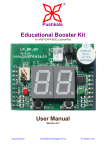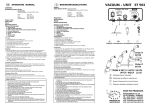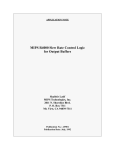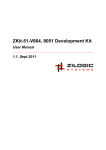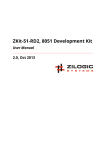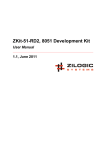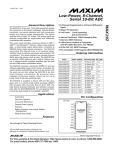Download Taruna-1 User Manual - Pushkala Technologies
Transcript
TM Pushkala Taruna - 1 An 8051 Microcontroller Development Board User Manual Version 1.0 www.pushkala.in © Pushkala Technologies Pvt Ltd 20th September 2010 Taruna -1 User Manual Copyright Information: Pushkala, Pushkala Technologies, and Pushkala's Logo are registered trademarks of Pushkala Technologies Private Limited, India. All other brands and product names in this document may be registered trademarks or copyrighted information of their respective owners. Disclaimer: The information in this document is believed to be accurate in all respects at the time of publication but is subjected to change without notice. Pushkala Technologies assumes no responsibility for errors and omissions, and disclaims responsibility for any consequences resulting from the use of information included herein. Additionally, Pushkala Technologies assumes no responsibility for the functioning of undescribed features or parameters. Pushkala Technologies reserves the right to make changes without further notice. Pushkala Technologies makes no warranty, representation or guarantee regarding the suitability of its products for any particular purpose, nor does Pushkala Technologies assume any liability arising out of the application or use of any product or circuit, and specifically disclaims any and all liability, including without limitation consequential or incidental damages. Pushkala Technologies products are not designed, intended, or authorized for use in applications intended to support or sustain life, or for any other application in which the failure of the Pushkala Technologies product could create a situation where personal injury or death may occur. Should Buyer purchase or use Pushkala Technologies products for any such unintended or unauthorized application, buyer shall indemnify and hold Pushkala Technologies harmless against all claims and damages. Contact information: Pushkala Technologies Pvt Ltd No. 38, "SHREEKANTA", West Anjaneya Temple Street, Basavanagudi, Bangalore – 560004 Karnataka, India Phone: +91 (80) 4160 9003 email: [email protected] web: www.pushkala.in Version 1.0 © Pushkala Technologies Pvt Ltd 2/24 Taruna -1 User Manual About this manual: This manual intends to discuss about the features, and usage scenarios of Taruna–1, an 8051 microcontroller development board. Audience: Any person who wishes to use Taruna – 1. Conventions used: Courier New font to represent code snippets and commands at prompt. Tip: Useful information related to topic of discussion. Warning!: Less severity information Note: Information which should be considered. Acronyms used: KB Kilo Bytes XRAM External Data Memory in form of RAM EEPROM Electrically Erasable Programmable Read Only Memory UART Universal Asynchronous Receiver Transmitter(Serial Port) SPI Serial Peripheral Interface TWI Two Wire Interface(similar to I2C) I2C Inter Integrated Circuit Communication from NXP ADC Analog to Digital Conversion DAC Digital to Analog Conversion CAN Controller Area Network from BOSCH GPIO General Purpose Input Output PWM Pulse Width Modulation bps Bits per second Version 1.0 © Pushkala Technologies Pvt Ltd 3/24 Taruna -1 User Manual Table of contents Taruna – 1 kit contents....................................................................................................5 Introduction to Taruna – 1..............................................................................................6 Identifying what is on board..........................................................................................7 Basic Development Setup.............................................................................................9 Quick Check................................................................................................................10 Software Setup...............................................................................................................11 Compiler – SDCC........................................................................................................11 Downloading utility – FLIP...........................................................................................11 First Program on Taruna1.............................................................................................12 Developing a simple LED toggling code.....................................................................12 Downloading and testing.............................................................................................14 Jumper settings.............................................................................................................17 I/O Expansion Port Details...........................................................................................19 Schematic.......................................................................................................................21 Contacts.........................................................................................................................24 Version 1.0 © Pushkala Technologies Pvt Ltd 4/24 Taruna -1 User Manual Taruna – 1 kit contents A standard packaged Taruna – 1 kit consists of the following: 1) Taruna – 1 development board 2) Null modem cable 3) DC power adapter 4) User manual CD with other relevant documentation 5) Invoice of Purchase, which is also a legal packing list 6) Any other peripheral modules ordered along with Taruna - 1 Version 1.0 © Pushkala Technologies Pvt Ltd 5/24 Taruna -1 User Manual Introduction to Taruna – 1 Taruna – 1 is an 8051 development board designed around Atmel's AT89C51ID2 high performance 8051 device variant. It contains 64KB of on chip Flash and 2KB of internal RAM(inclusive of standard internal and XRAM). For non-volatile data storage 2KB of on chip EEPROM is also available. The device can operate up to a maximum clock frequency of 60MHz. AT89C51ID2 is a peripheral rich microcontroller, which comes with UART, SPI, TWI, Keyboard interface, GPIO, PWM, and many other embedded on chip. For further details on this device, please refer to the datasheet of AT89C51ID2 available at Atmel's website. Taruna – 1 can be considers as a Single Board Computer[SBC] for the reasons that, the basic required functionality to develop a simple Embedded control system is readily available on board. Eight on board LEDs help a developer in displaying/debugging the status of code/program. Basic UART is brought out as a RS232 serial port for PC connectivity and In system Programming[ISP]. All peripheral interfaces are brought out to an easily accessible I/O Port Expander Connector(further section of this document explains these in detail). For external peripheral compatibility the SBC can be powered at either 5VDC or 3.3VDC. Following block diagram gives a glimpse of Taruna – 1's architecture. Up to 60MHz Clock RS232 Port Expander GPIO Programming & Interrupts 5V or 3.3V Power Supply AT89C51ID2 I2C SPI Timing Figure – 1: Block diagram of Taruna – 1 One can increase the capability of Taruna – 1 through its external add-on peripheral modules. Currently ADC, DAC, RTC, LCD, Keyboard, and CAN modules are available. Version 1.0 © Pushkala Technologies Pvt Ltd 6/24 Taruna -1 User Manual Identifying what is on board Figure 2 is the top side view of Taruna – 1, and the accompanying legends identifies the main components on board. 1 2 3 4 5 6 7 10 8 9 11 13 12 14 15 16 17 20 18 21 22 19 Figure – 2: Top view of Taruna – 1 Version 1.0 © Pushkala Technologies Pvt Ltd 7/24 Taruna -1 User Manual Legend # Description 1 DC input power jack 2 DB9 Male connector for RS232 serial communication 3 Various test points(refer Trouble Shooting section for details) 4 Power supply voltage regulator IC 5 Reset Switch 6 Power LED 7 Active low Interrupt 0[INT0] switch 8 Jumper 7[JP7] 9 Jumper 6[JP6] 10 Jumper 3[JP3] 11 Active low Interrupt 1[INT1] switch 12 Program Store Enable Switch[PSEN] 13 Primary clock crystal – 22.1184MHz 14 AT89C51ID2 microcontroller 15 Jumper 5[JP5] 16 LED array connected to Port 2 17 Jumper 1[JP1] 18 Jumper 4[JP4] 19 Jumper 2[JP2] 20 Sub clock crystal – 32.768KHz 21 Port Expander pads 22 P1 I/O Bus connector Version 1.0 © Pushkala Technologies Pvt Ltd 8/24 Taruna -1 User Manual Basic Development Setup Figure – 3: Setup of cross development environment. Setting up development environment is very simple. Plug in the supplied Null Modem Cable's one end to Taruna – 1's “DB9 connector” as described in previous section(RS232 Connector), and the other end to PC's serial/com port. To power up the board just plug-in the DC power adapter's DC jack to “DC input power jack” on Taruna – 1 and the 230V pins to the socket and power on. Read through further sections to know about software required for cross development and a quick test scenario. Warning!: Not all PCs or Laptops have serial port/s built in. Arrange a USB to Serial converter in that case. Version 1.0 © Pushkala Technologies Pvt Ltd 9/24 Taruna -1 User Manual Quick Check This section describes about how to test your Taruna-1 board on first power up. 1. Connect the Taruna-1 as per the guidelines given in the previous section. 2. Open Minicom in GNU/Linux or Hyper Terminal in WindowsXP or similar serial communication utility of your choice. 3. Setup the serial communication utility with following parameters: • Baud Rate = 9600bps • Data bits = 8 • Stop bits = 1 • Flow control = None 4. Power up the board. 5. You should see “Taruna-1 Ready” on your serial communication utility. 6. Now press key from 1 to 8 on your PC, corresponding LED will switch on. 7. Press 0 to switch off the glowing LED. This completes the test, and now the setup is are ready to be explored. If in any case you do not succeed with the above steps immediately contact [email protected] and report the problem. Make sure your email subject is specified as Taruna-1<serial number(SN) as specified on your board>. Note: Once you reprogram(download your code) the board, you can not run this test again. This is factory programmed test code and will be erased once you program the board with your code. Version 1.0 © Pushkala Technologies Pvt Ltd 10/24 Taruna -1 User Manual Software Setup Compiler – SDCC Small Device C Compiler – SDCC is an Open Source C Cross Compiler used for compiling or generating binary executable files in Intel Hex format for the Taruna-1 board. Current version of the same is supplied on the CD accompanying the development board. To download the latest version log onto http://sdcc.sourceforge.net/ Installation details are available in the SDCC user manual, install accordingly on your favorite Operating System. Tip: There are many IDEs which support SDCC as an add-on compiler, to help development of 8051 programs. You may explore one if interested. Else a simple text editing tool and command prompt is sufficient to do the job! Note: Usage of a cross compiler or developing 8051 programs in C or assembly is beyond the scope of this document. Refer to Useful Information of this document to get related information. Downloading utility – FLIP To download the executable on to the microcontroller, in our case AT89C51ID2, Atmel provides an easy to use GUI based programming utility called FLIP. Current version of FLIP is distributed on the CD accompanying the development board. To download the latest version log on to http://www.atmel.com/. Installation is self explanatory. Install one instance on your favorite OS and get ready to program. Usage details will be discussed in the following section. Version 1.0 © Pushkala Technologies Pvt Ltd 11/24 Taruna -1 User Manual First Program on Taruna1 Developing a simple LED toggling code Step – 1: Key in the following code in your favorite text editor and save as ledtoggle.c /* * File * * Date * * Author * * Description * * * Version * * Modificatios * */ : ledtoggle.c : 28-06-2010 : Pushkala <[email protected]> : This program toggles one Red LED on Taruna - 1 board. : 0.1.0 : No modifications yet /* Include SFR declarations header file */ #include <8051.h> #include <8052.h> #include <at89C51ed2.h> #define MAX #define FOREVER 30000 1 /* allocate green LED: '1' = ON; '0' = OFF */ #define LED P2_0 #define LED_ON P2_0 = 1 #define LED_OFF P2_0 = 0 void softDelay(unsigned long count); void main ( void ) { /*Clear Port 2*/ P2 = 0; /* forever */ while ( FOREVER ) Version 1.0 © Pushkala Technologies Pvt Ltd 12/24 Taruna -1 User Manual { softDelay(30000); /*LED = 1;*/ LED_ON; softDelay(30000); /*LED = 0;*/ LED_OFF; } } void softDelay(unsigned long count) { unsigned long i = count; for ( i = MAX; i > 0; i-- ); } Step – 2: Compile the saved c file using sdcc command, example shown below. Prompt->sdcc ledtoggle.c On successful compilation you will observe many files created with name ledtoggle but with different file extensions. File with .ihx or .hex extension is the one which should be downloaded on to the uC. Next section describes about how to program the uC. Tip: Study the SDCC user manual to know more about various compilation options. Version 1.0 © Pushkala Technologies Pvt Ltd 13/24 Taruna -1 User Manual Downloading and testing 1. Open the FLIP utility, make sure Taruna – 1 is connected to your Laptop/PC via the Null Modem cable. 2. Click on “Select Target Device” icon to select AT89C51ID2. 3. Click on “Load HEX File” icon to browse and select ledtoggle.ihx file. 4. Power up the board using the supplied DC Power Adapter. 5. Take Taruna – 1 to programming mode by following the below mentioned key press sequence on board: a. Press and hold the PSEN key (SW4), do not release! the key. b. Now Press and release the RESET key (SW1). c. Release the PSEN key now. 6. Establish communication between FLIP and Taruna – 1 by clicking “Select a Communication Medium” icon. Select RS232. Figure – 4: FLIP main screen. Version 1.0 © Pushkala Technologies Pvt Ltd 14/24 Taruna -1 User Manual 7. Select appropriate comport available on your Laptop/PC and click “Connect”. Figure – 5: Communication port selection pop up window. 8. On successful connection you will see all the masked icons and information will be unmasked. Now click “Run” icon to program the uC. Figure – 6: FLIP ready for programming. Version 1.0 © Pushkala Technologies Pvt Ltd 15/24 Taruna -1 User Manual 9. After successful programming you may observe the Green color buttons next to the activities which were carried out during programming. 10. Now click “Start Application” icon or press RESET key on board to launch the application. Figure – 7: FLIP screen depicting successful programing state of uC. Note: Do not alter any other parameter in the FLIP utility. If attempted you may loose the programming ability of the device. Tip: Look out for other example codes in the CD or log on to www.pushkala.in Version 1.0 © Pushkala Technologies Pvt Ltd 16/24 Taruna -1 User Manual Jumper settings There are seven Jumpers[JP1 to JP7] to configure various settings of Taruna – 1. This section gives you an insight about various settings using respective Jumpers. These jumpers are either two pin or three pin variants. In each jumper the pin with square pad is Pin 1 and other are in order 2 and 3, as shown in figure below. The black thick line next to the pad pin represent the presence of a short link. Short link is simple two pin conductive connector. Short links are provided for all jumpers even though in some they are not utilized. No short link b/w Pin 1 & 2 Short link b/w Pin 1 & 2 3 pin jumper with short link b/w pin 2 & 3 Figure – 8: Jumper connection schemes Jumper 1[JP1]: Enable/Disable Port-1 pull-up resistors. Each pin of Port-1 of AT89C51ID2 is connected with a 390ohms pull-up resistor. Using JP1 one can enable or disable these pull-resistors. Standard Setting: Disabled Short link between Pin 1 and 2 Enabled No short link between Pin 1 and 2 Disabled Jumper 2[JP2]: Select Program Memory. AT89C51ID2 provides an option to interface external program memory addressable up to 64KB, this option is selectable by asserting the EA pin to logic 0. Using JP2 one can switch between internal/on-chip program memory or external program memory. Standard Setting: Internal Program Memory Short link between Pin 1 and 2 Internal Memory Short link between Pin 2 and 3 External Memory Jumper 3[JP3]: Enable/Disable TWI pull-up resistors. The SDA and SCL lines of TWI interface has two pull-up resistors connected to VCC through JP3. JP3 enables or disables these pull-up resistors. Standard Setting: Disabled Version 1.0 Short link between Pin 1 and 2 Enabled No short link between Pin 1 and 2 Disabled © Pushkala Technologies Pvt Ltd 17/24 Taruna -1 User Manual Jumper 4[JP4]: Enable/Disable LED array. 8 LEDs are connected individual pins Port-2 of AT89C51ID2. Using JP4 one can enable or disable this array. Standard Setting: Enabled Short link between Pin 1 and 2 Enabled No short link between Pin 1 and 2 Disabled Jumper 5[JP5]: Enable/Disable Sub Clock Crystal. A 32.768KHz crystal is routed through JP5 to Port1.0 which is also crystal B input pin. JP5 enables or disables this connectivity. Standard Setting: Enabled Short link between Pin 1 and 2 Enabled No short link between Pin 1 and 2 Disabled Jumper 6[JP6]: Enable/Disable VCC to Taruna – 1. VCC to complete board can be cut off using JP6. This jumper is in series with voltage regulator output and other Taruna – 1 components. Standard Setting: Enabled Short link between Pin 1 and 2 Enabled No short link between Pin 1 and 2 Disabled Jumper 7[JP7]: Select Operating Voltage(VCC). AT89C51ID2 operates any where between 2.7VDC to 5.5VDC VCC. Two standard operating voltages in this range are 3.3VDC and 5VDC. Hence to support peripheral interface at these operating voltages JP7 can be used to switch between 5VDC and 3.3VDC. Standard Setting: 5V Version 1.0 Short link between Pin 1 and 2 5V Short link between Pin 2 and 3 3.3V © Pushkala Technologies Pvt Ltd 18/24 Taruna -1 User Manual I/O Expansion Port Details All the pins of AT89C51ID2 are brought out on to two connecters called P1 and Port Expander. Some of the pins are duplicated and grouped according to some common functionality to aid easy plug-in of add-on modules from Pushkala. P1 and Port Expander are mapped 1:1. User can expand other compatible peripherals through these ports. Information about add-on modules available from Pushkala are published on www.pushkala.in Look at Figure – 4 to understand the pin grouping and the following table describes about each pin functionality. Figure – 9: Pin or Functionality grouping of P1 and Port Expander. Table describing functionality of each pin on P1 and Port Expander, # means active low: Functionality Pin # Pin # Functionality VCC 80 79 GND SPI – MISO for ADC or P1.5 78 77 GND SPI – MOSI for ADC or P1.7 76 75 SPI – SCK for ADC or P1.6 SSTRB for ADC or P2.4 74 73 GND #CS for ADC or P2.3 72 71 GND No Connect 70 69 No Connect No Connect 68 67 No Connect VCC 66 65 GND SPI – MOSI for DAC or P1.7 64 63 SPI – SCK for DAC or P1.6 LDAC for DAC or P2.6 62 61 GND #CS for DAC or P2.5 60 59 GND Version 1.0 © Pushkala Technologies Pvt Ltd 19/24 Taruna -1 User Manual No Connect 58 57 No Connect No Connect 56 55 No Connect VCC 54 53 GND uC – ALE 52 51 GND uC – #PSEN 50 49 GND TWI – SDA 48 47 TWI – SCL P3.7 or #RD 46 45 P3.6 or #WR P3.5 or T1 44 43 P3.4 or T0 P3.3 or #INT1 42 41 P3.2 or #INT0 P3.1 or TXD 40 39 P3.0 or RXD P1.7 or CEX4 or SPI MOSI 38 37 P1.6 or CEX3 or SPI SCK P1.5 or CEX2 or SPI MISO 36 35 P1.4 or CEX1 P1.3 or CEX0 34 33 P1.2 or ECI P1.1 or T2EX or SPI #SS 32 31 P1.0 or T2 or XTALB1 P2.7 or A15 or CS for CAN 30 29 P2.6 or A14 or LDAC for DAC P2.5 or A13 or CS for DAC 28 27 P2.4 or A12 or SSTRB for ADC P2.3 or A11 or CS for ADC 26 25 P2.2 or A10 or RS for LCD P2.1 or A9 or R/W for LCD 24 23 P2.0 or A8 or Enable for LCD P0.7 or AD7 22 21 P0.6 or AD6 P0.5 or AD5 20 19 P0.4 or AD4 P0.3 or AD3 18 17 P2.2 or AD2 P0.1 or AD1 16 15 P0.0 or AD0 No Connect 14 13 No Connect No Connect 12 11 No Connect VCC 10 9 GND P3.3 or #INT1 for RTC interrupt 8 7 GND P3.2 or #INT0 for RTC interrupt 6 5 GND TWI – SCL for RTC 4 3 GND TWI – SDA for RTC 2 1 GND For further details refer to the schematic of Taruna – 1. Tip: Refer to datasheet of AT89C51ID2 for more details on microcontroller pins and its functionality. Version 1.0 © Pushkala Technologies Pvt Ltd 20/24 Taruna -1 User Manual Schematic Figure – 10: Microcontroller Schematic. Version 1.0 © Pushkala Technologies Pvt Ltd 21/24 Taruna -1 User Manual Figure – 11: Port Expander Schematic. Version 1.0 © Pushkala Technologies Pvt Ltd 22/24 Taruna -1 User Manual Figure – 12: Power Supply and Communication Schematic. Version 1.0 © Pushkala Technologies Pvt Ltd 23/24 Taruna -1 User Manual Contacts Technical : [email protected] Sales : [email protected] Generic : [email protected] Website : www.pushkala.in Postal Address : Pushkala Technologies Pvt Ltd No. 38, "SHREEKANTA", West Anjaneya Temple Street, Basavanagudi, Bangalore – 560004 Karnataka, India Version 1.0 © Pushkala Technologies Pvt Ltd 24/24
























